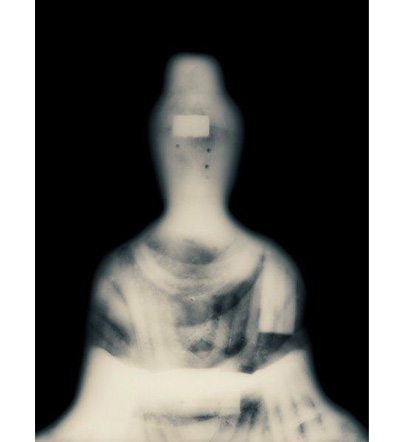
David Maisel History’s Shadow AB3, 2010

Ethereal, delicate yet raw,
David Maisel’s new book of photography,
History’s Shadow (Nazraeli Press) breathes new life into the seemingly fragile framework of ancient art. Scientific in nature – the images are actually museum conservation x-rays Maisel’s re-photographed – the undertones are pure art. Drawing from three-dimensional art objects that predate photography (courtesy of the Getty Museum, L.A. and the Asian Art Museum, San Francisco), Maisel’s photos reveal a bizarre facet of art preservation not typically displayed on a museum placard. These x-rays, intended to expose the structural well-being of valuable antiquities, have been turned on their head and transformed into some sort of meta-art for the masses.
(more…)
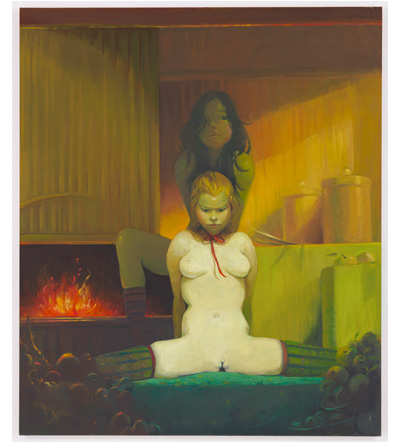
Lisa Yuskavage Fireplace 2010. All images courtesy of David Zwirner

Those visiting David Zwirner’s Chelsea gallery this month will find themselves in the provocative company of a series of lurid, disrobed figures, polished with the curious appearances of feral angels. These cherubic yet licentious effigies feature recurrently in the imagination of Lisa Yuskavage, here in her third solo exhibition with the gallery; feminine forms uncloaked before vivid, polychromatic dreamscapes, depicted in candy-hued, saccharine palettes.
“I have always worked, even as an undergraduate, with the subject of women, because that’s what made sense to me, it was as if I was an actress and that (the subject) was the protagonist that I was working through. Inevitably, people will ask me – when are you going to paint a man? It would be like asking Meryl Streep – when are you going to go in drag?”
Emerging onto the New York arts scene in the late 90s, amongst contemporaries such as John Currin and Elizabeth Peyton, Yuskavage’s brand of feminine lasciviousness has consistently proven to mystify and bemuse, provoke vehement feminist discord and analysis through the prism of gender politics – yet, the paintings remain products of distinctly personal realms; intrinsic psychological divulgences,
(more…)
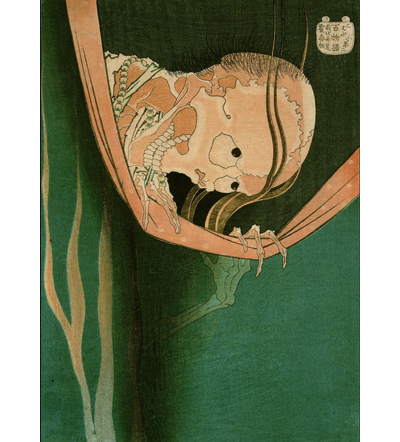
Hokusai, Kohada Koheiji, © Katsushika Hokusai Museum of Art

The late-Edo period master Hokusai left two artistic legacies: one in Japan as a preeminent innovator in the ukiyo-e style, and one in Europe as an icon of the hugely influential japonisme movement. Hokusai’s century-straddling career as a painter, printmaker, and illustrator is the subject of Hokusai, the artist’s first major retrospective in Germany, at the Martin-Gropius-Bau Berlin through October 31st.
Ukiyo-e, or “floating world” imagery, was an immensely popular style of genre painting in Japan by the late 1770s, when Hokusai was beginning his career in Tokyo. Though skilled in the detailing and attentive characterization required of the atmospheric ukiyo-e, he almost immediately moved beyond its traditional subject matter of urban revelry. In applying ukiyo-e’s ephemeral technique to the natural world, Hokusai expanded the genre to include expressive landscapes, seascapes, and closely observed studies of plants, and produced some of Japan’s most famous woodblock prints in the process.
Click for Slideshow
(more…)

Jonas amid his personal archives. Photography by Derek Peck

From my regular column in AnOther magazine.
Jonas Mekas is a man who clearly loves a good archive. Besides being a filmmaker, artist, writer and poet, Mekas is probably the most dedicated and genre-conscious pack rat in New York City. Over the last forty years he’s become widely known for being a co-founder and chief guardian of the Anthology Film Archive, the largest collection of underground and experimental film in the world. So it shouldn’t have been a surprise when I arrived at his Brooklyn loft the other week and discovered the entire space filled with loosely stacked boxes, folders, photographs, glassines and slides of cut film reels, writings, poems, magazines, posters, and so on. They covered every available surface. Books and binders lined the walls. Nothing was overly fastidious or ordered – in fact, the stacks were actually rather loosely assembled – but there was nothing messy either. And Jonas knew exactly where everything was. At first, I was confused. I thought perhaps he was housing a portion of the Anthology Film Archives in his own living room. But he assured me he wasn’t. This was his own work, he said, a lifetime of thought and creativity and its artifacts. The next logical thought that came to mind was, How did he live here? There seemed to be no place to relax, recline, or spread out a big feast for family and friends. There was nowhere to not work. But after only a few minutes visiting I realised this is how he lives. Mekas is so consumed with the art of documenting life and collecting its leftovers that it has become entirely second nature to him, as automatic as breathing air.
(more…)

Paul Cadmus, 1928, by Luigi Lucioni (American, 1900–1988)

Thanks to popular television shows like HBO’s
Boardwalk Empire and Ken Burns’ new PBS documentary series
Prohibition, we’re well informed about what went on socially and politically in the 1920s, from the rise of the Mafia to the new freedoms women enjoyed as voters and flappers. But what about visual art? What did painters, sculptors and photographers produce during the ten years between the Great War and the Great Depression?
Youth and Beauty (Skira Rizzoli), a beautiful coffee-table book accompanying an exhibition opening at the Brooklyn Museum in October, gives plentiful answers to that question. Of course, we know what happened artistically in postwar Europe: it was the Golden Age of Modernism, when artists like Picasso, Mondrian and Kandinsky were producing some of their best work. Newly mature, Modernism bore its own wild children–Dada, Surrealism and Futurism among them.
(more…)
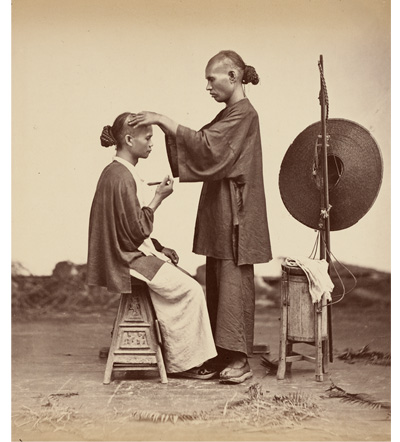
John Thomson Itinerant Barbers c. 1868-72

Photography came to China at the start of the 1860s, introduced by foreigners but enthusiastically embraced by natives. In the decades leading up to the twentieth century, every incarnation of the new technology managed to replicate itself in the Chinese popular consciousness: formal landscapes, official portraiture, personal documentation, and architectural and street scenes. These extraordinarily rare images are the meat of Sheying: Shades of China 1850-1900, opening September 15th at Throckmorton Fine Art.
The black-and-white photos, a mixture of work by transplanted Europeans and fledgling Chinese photographers, have the painterly shades and delicate composition of Europe’s ongoing pictorialism movement. But the pictures are unmistakably Chinese in subject matter. In a cramped Cantonese street, stall banners blot out the sky. Two prisoners pose stoically in cangues. There are countless images of harbors, filled with the bobbing handmade boats that powered the national economy. For all the influence the relatively established European photographers held, China proved itself to be an inimitable sitter. The collection provides a fascinating look at an empire before industrialization.
Click for Slideshow
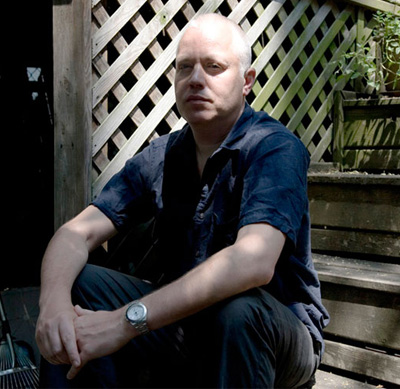
David Strettell Photography by Derek Peck


From my regular column in AnOther magazine.
David Strettell is the founder and owner of Dashwood Books, a tiny but enormously influential photography bookstore located on Bond Street in the Bowery section of Manhattan. Since opening in 2005, Dashwood has become New York City’s insider resource and social nexus for the latest in contemporary international photography. With an impressive run of book releases, signings, and talks by some of the top names in photography today, as well as pursuing its own publishing projects and being known for stocking unique titles, rare collectors’ editions, and short-run monographs of self-published work, Dashwood has come to present a broad but distinct range of today’s photographic work through the curatorial passion of one man. Previously, Strettell had assisted Mario Testino and then worked for the legendary Magnum Photo cooperative for 12 years. After leaving Magnum, Strettell says he took six months off to decide what was next for him, and chose to open Dashwood. Recently, I met with David at his East Village flat for tea, conversation, and to take a few pictures of the man behind the books.
(more…)
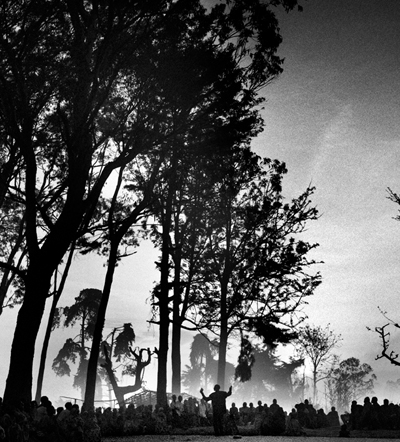

The black-and-white photography of Marcus Bleasdale, who has spent over a decade documenting the conflict-torn Congo, includes some of the most comprehensive and richly textured images to have come out of the area. Bleasdale has a knack for capturing the spontaneous – his camera immerses itself in successive, wildly contrasting environments and waits for his subjects to reveal themselves in a single perfect, instinctive gesture. Thus his photos are all about movement, and the way it animates everything from a soldier-filled jungle to a children’s municipal shower. Bleasdale’s Congo work is the focus of a show at Anastasia Photo opening September 15th.
Click for Slideshow


London-based fashion and social documentary photographer, Iain McKell, is notable for his arresting and unconventional images of high-fashion and youth subculture. For his recent project, The New Gypsies, McKell spent over ten years tracking and living with a small group of present-day nomads. Seeking an alternative to western capitalist society, the New Gypsies are rural anarchists. Evolving from the New Age Travellers – a group of post-punk anti-Thatcher protestors living in buses in England in the mid-80’s – the New Gypsies roam the English countryside in elaborately-decorated horse-drawn caravans, free from the reigns of urban society. Unaffiliated with the infamous ROMA gypsies residing in Central and Eastern Europe, they share no ethnographic core. Simultaneously romantic and practical, theatrical and natural, wistful and raw, McKell’s breathtaking photographs offer a first glimpse into this beautiful and subversive community. In conjunction with his current exhibit at the Clic Gallery in New York, McKell spoke with PLANET° about the origins of the project, the New Gypsies unique sense of style and visions of the future.
Click for Slideshow
(more…)
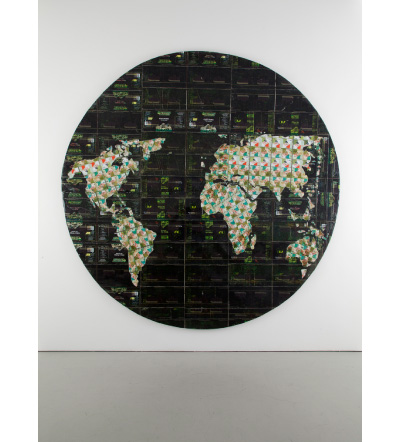
Adel Abdessemed. mappemonde - olive, 2011. Courtesy the artist and David Zwirner, New York. Photograph by Jean Vong

It’s been 19 months since the monstrous 7.0 magnitude earthquake struck Léogâne, Haiti (16 miles west of Port-au-Prince) on January 12, 2010. Despite the unprecedented outpouring of global aid, funds and support, Haiti remains consumed by the aftermath of what the quake left behind. According to official estimates, 300,000 people were injured, 1.3 million displaced, 97,294 houses destroyed and another 188,383 damaged. To say nothing of the disputed death toll, subsequent cholera outbreak, political unrest, and general foot-dragging of aid disbursement and reconstruction projects. Quite simply, the Haitian people have suffered inexorably and continue to do so.
Several months ago, New York gallerist/art dealer David Zwirner teamed up with comedian/actor Ben Stiller to form Artists for Haiti, a high-profile charity art auction that will donate one hundred percent of its sales to support education and health programs for Haitian children. The auction will take place on September 22 at Christie’s, New York and will include major works from some of the world’s most prominent artists including: Adel Abdessemed, Louise Bourgeois, Chuck Close, Urs Fischer, Jasper Johns, Jeff Koons, Paul McCarthy, Chris Ofili, Raymond Pettibon, Cindy Sherman, Ed Ruscha, and Zhang Huan, among others. A preview exhibition will be held at the David Zwirner Gallery in New York from September 6-10.
(more…)





 Facebook
Facebook Permalink
Permalink Digg
Digg Reddit
Reddit LinkedIn
LinkedIn StumbleUpon
StumbleUpon Tumblr
Tumblr











